As alluded to in last week’s Bird Photography feature “The Big Strut,” the chance to photograph a Ring-necked Pheasant crowing has eluded me for some years. I see cock pheasants crow occasionally and hear pheasants crow more often, but to be in the right location, with the right sunlight, close enough, and to have the bird explode into its crowing sequence that only lasts 2 or 3 seconds is an exceptionally difficult wish to fulfill. It’s the same story for photographing males fighting during a spring interaction – I see it from time to time, but always from a long distance away from the action.
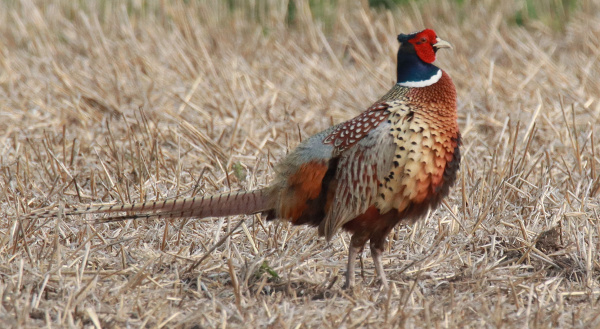
That said, I have had the chance to photograph a crowing pheasant that was facing me in 2018, and I was lucky to photograph 2 Ring-necks fighting over an extended period in 2020. But since then, spring after spring, the chance to photograph crowing or fighting pheasants has evaded me, but I’m always on the lookout for my next chance to document each of these action-packed activities as a photo series.
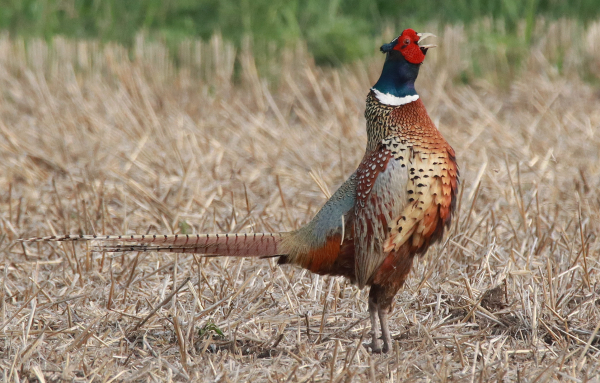
After cruising through Long Lake National Wildlife Refuge last Thursday afternoon, photographing a number of birds ranging from White Pelicans to Western Grebes, Gadwalls, Bobolinks, and even the first Burrowing Owl I’ve ever seen in the vicinity of the refuge (and the first Burrowing Owl I’ve seen in a couple decades east of the Missouri River), I exited the refuge the same way I entered it, from the main road east of Highway 83. With the sun lower in the western sky then, pheasants were becoming more active and when I caught sight of a male Ring-necked Pheasant, then another, with 4 females closer to the bigger male that I was closest to. Not close, but probably close enough.
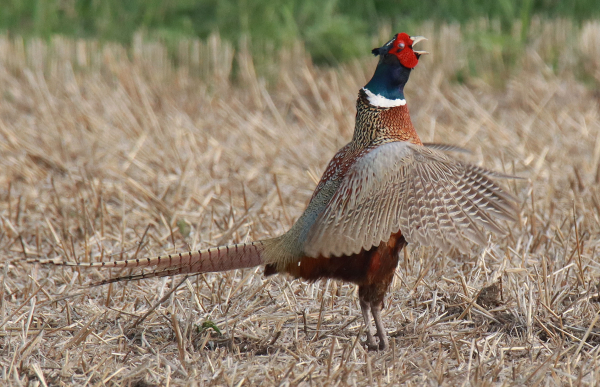
I made a last moment adjustment to position my mobile blind (my car) in the potentially best position to photograph any action that might transpire and turned off the ignition. I quickly raised my camera to the window and focused on cock pheasant number one, leaning my zoom lens on the window frame. The males were quite aware of one another, but the larger one closer to me seemed to be following the females, who showed no interest in him. That’s when I noticed the bigger male began walking broadside near 2 of the females, holding his body, head, and tail horizontally while he began slightly bobbing his head up and down in repeatedly. It seemed there was a potential for some action, most likely a crowing display, and I was on high alert as I watched through the camera lens.
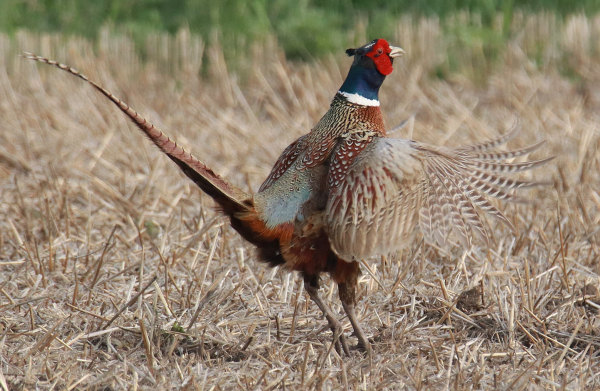
Indeed, the male suddenly stood upright and ruffled its body feathers as though he was about to begin shakin’ all over. Instead, from his fluffled position, he rapidly stretched his body upright and crowed! I was in sync with the Ring-neck and began photographing as soon as it began its ruffle, following through the dramatic crowing stretch and continuing as the rooster flapped its wings forward, then down – a movement that actually lifted the pheasant a little above ground as it tipped its tail upward too.
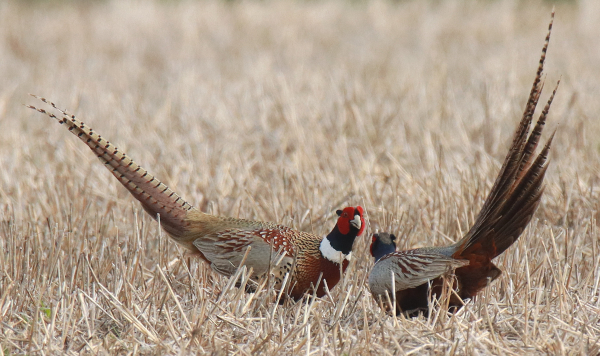
It all happened so very quickly, but I was ready; and because I use the “Continuous mode” setting on my camera, when the pheasant began its display – as it ruffled – I pressed the shutter button and held it to take a series of photos at the raging speed of 5 per second. The crowing action probably took less than 2 seconds, and I released the shutter button when it was clear the crowing display was complete – ending just as it started, with the pheasant’s body feathers somewhat fluffed out from its body.
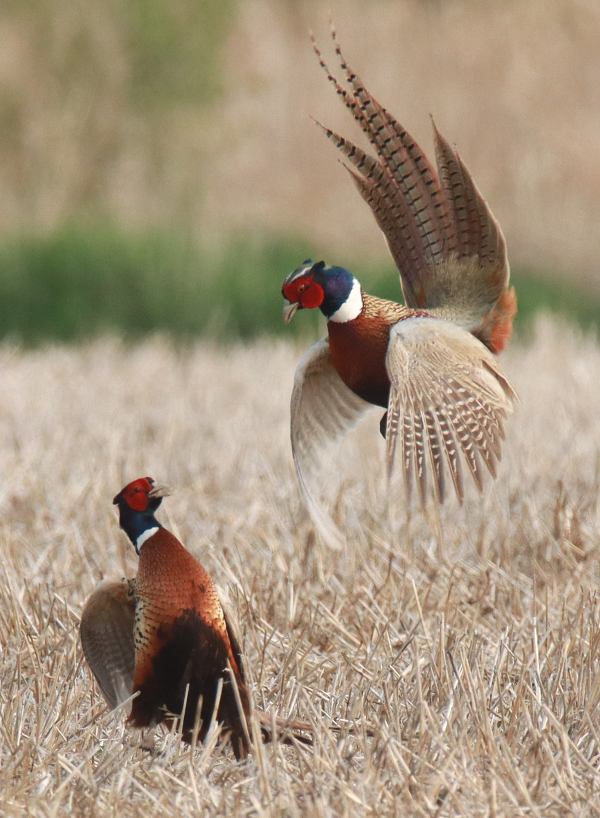
Some serious pheasant fighting ensued, providing some fast-paced action from both males – mostly wing flapping and tail spreading, some jumping and some jabbing with their leg spurs and beak (600mm zoom lens, f-8 aperture, 1/1000 shutter speed, 800 ISO).
|
I watched a couple more moments as the male strutted forward past 2 females, standing high and puffing out its chest, but the females continued feeding, ignoring the male’s attention, as usual. Believing the action was complete, I took a quick look the crowing photos on the LCD screen on the back of my camera to see how the images looked. As the first photo materialized on the viewer I peered up again, only to see the big male and the second dude were eyeing one another face to face, beak to beak from a horizontal position close to the ground! “Cock Fight!”
As quickly as I could raise my camera and focus on the pheasants, they erupted into the air with their wings flailing, tail feathers spread, and legs in position to jab forward or backward, using the sharp spurs on the base of their legs to try to inflict hurt or damage to the other male. This segment of the action was especially dramatic but it only lasted a short period, less than a half-minute, but long enough for me to record moments of interaction between the combatants.
Again I held the shutter button down as long as there was action – for 3 or 4 photos while the birds were active; then waiting a moment as the pheasants repositioned a bit, then burst into battle again. Judging from past experiences, this turned out to be a very quick and calculated fight interaction that ended as pheasant number 2 gingerly stood upright, turned, and slowly walked away from the big boy. And that’s when it hit me, that I had just fulfilled 2 pheasant action photo sequences in the span of just a few minutes!
Considering how super-hard it is to be in position and ready to photograph a cock pheasant crowing, and maybe even harder to be on hand for a pheasant cock fight, the chances of it all coming together back to back must have astronomical odds against it happening. Yet the 2 activities just played out before me as I recorded split-second tidbits of the action in sequence – wooo-wee!
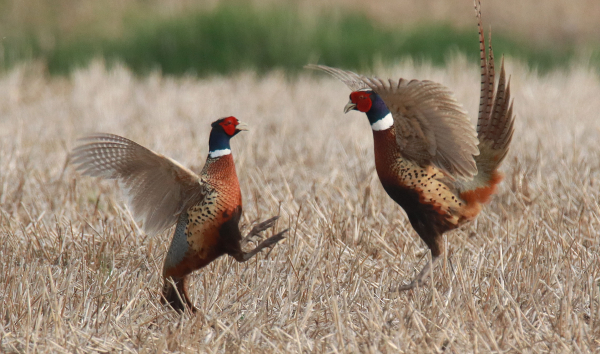
As the big male returned to the foraging females, I thought it might be inspired to crow again in acknowledgement of running off male number 2, but he actually began feeding too. After catching my breath, I continued down the road, which seems to be something of a hub of Ring-necked Pheasant activity in the region, and I observed 5 other males positioned near feeding females, with 2 of them getting involved in a longer, but distant pheasant phight.

While spring migration may be winding down, it appears the peak of pheasant mating period is approaching, with males positioning for mating rites with area females. This colorful pheasant action could continue through the weeks of June, and it could even intensify some more, but the males were certainly feeling it last Thursday evening, and I’m sure glad the timing, positioning, lighting, and Luck were with me and my camera and lens combination. It’s photo sessions like this one that makes a person feel like things are going your way – and gosh, this spring I’ve had that feeling often with my camera in hand. Onward & Upward!
Article and Photograph by Paul Konrad
Share your bird photos and birding experiences at editorstbw2@gmail.com